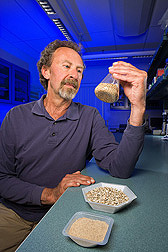by Allison Younkins
“Corn Smut” is both a plant cancer and a tailor. This maize fungus does not tailor clothes but it does tailor its genes to attack the host tissue it is infecting. This April, researchers and Stanford unlocked some astonishing secrets about how corn smut manipulates genes in its genome to affect its host more severely.
The researchers used laboratory techniques such as DNA microarrays, which allowed them to seem which genes in the pathogen’s genome were activated. What they found will inevitably change the way pathologist’s study plant pathogens and human cancers. Their experiment showed that the pathogen had different active genes when it was infecting various parts of the plant including the seedlings or the adult leaves. About 30% of the pathogen’s genome was activated no matter where the infection was located. The activation of the remaining 70% varied depending on the location of the infection. This phenomenon has been overlooked in the past because normally only tissues from one cell type are studied in an experiment.
These findings may allow scientists to return to pathogens retroactively and discover new information about the mechanism of plant diseases including corn smut.
This is a significant finding for the plan pathology community but it also has implications for human disorders. Corn smut is a tumor-causing plant cancer, and researchers believe that information from this study could fuel new experiments in cancer research. Their discoveries about this plant cancer suggest that diseases such as cancer can alter their genetic material to better infect a host. If the activated genes can be targeted, this could create more specific treatments and medications for cancer.
Corn smut has traditionally been overlooked as a research interest because it does not devastate maize crops and is not harmful to humans who eat infected maize. It is common in Mexico for the plant tumors to be used in food and can even be grown intentionally. However, this seemingly unimportant pathogen may hold a wealth of information about how diseases attack their hosts and what we can do to stop them.

Want to hear a Stanford University researcher speak about her research on corn smut? Check out the link below
 10% or 20%.” Similarly, most common agricultural crops cannot survive water loss of 20-30%.
10% or 20%.” Similarly, most common agricultural crops cannot survive water loss of 20-30%.

